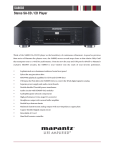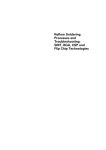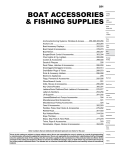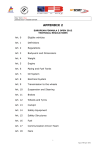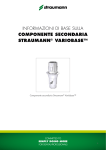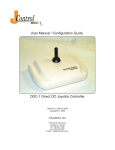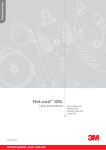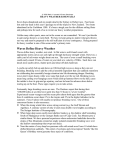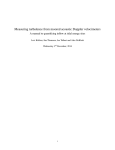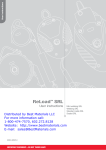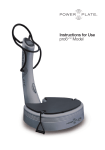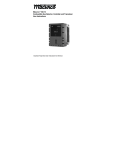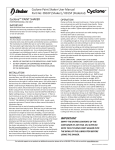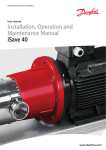Download Safety Warning Insert
Transcript
Thank YoU for selecting rope manufactured by Samson The improper use of rope may be dangerous. Because of the wide range of factors potentially affecting product performance, you are urged to implement the guidelines and instructions set forth herein regarding rope use, inspection, and retirement. > Use the right size and rope construction for the job > Make sure you use the rope safely > Never stand in line with the rope under tension > Avoid abrasive surfaces > Do not overload rope > Do not shock load rope > Do not bend rope over sharp corners > Check temperature rating before using rope in hot environments See inside for additional information on safe usage of rope. BE ADVISED: The most current and accurate content regarding rope use, inspection, and retirement can be found at SamsonRope.com or in the Samson Rope User’s Manual. The information found at SamsonRope.com may supersede the information in this and previous printed materials. WARNING The use of rope for any purpose subjects it to varying levels and modes of tension, bending, friction, and mechanical damage; as well as a wide range of environmental variables such as temperature, chemical exposure, etc. Regardless of application, as fiber rope is exposed to particular service conditions it will begin to suffer some level of degradation. Maximizing rope performance and safety involves selecting the correct rope, using optimal handling during its use, and retiring it from service before it creates a dangerous situation. Ropes are serious working tools, and when used properly, they will give consistent and reliable service. The cost of replacing a rope is extremely small when compared to the physical damage or injury to personnel a worn out rope can cause. ROPE SELECTION Selecting a rope involves evaluating a combination of factors. Some of these factors are straightforward, like comparing rope specifications; others are not easily quantified, such as a preference for a specific color or how a rope feels in your hand. Due to this complexity, it is important for users to consider which variables are critical for their application in order to select rope products that are truly fit-for-purpose. The most common considerations are outlined in detail below: Strength Rope tensile strength is one of the characteristics most commonly utilized for selecting rope products. In general, it is important to match a rope’s strength to the requirements of the application. Oftentimes such requirements are clearly stipulated by regulatory and certification bodies or other safety requirements. The strength should always be some factor greater than the intended working load for a given application. While there is a tendency to select products with the highest tensile strength possible, care should be taken to assure other performance properties are not sacrificed. Our published strengths and test results reflect, as accurately as possible, the conditions under which they are to be used. Because the vast majority of ropes are terminated with a splice, all published strengths herein are spliced strengths. All ropes are also tested spliced, unless otherwise noted. This assists the customer in selecting the appropriate size and strength of rope for the application, and to ensure the utmost in safety and length of service life. When comparing our data to that of other rope manufacturers, please be sure that spliced strengths are used. WORKING LOADS AND SAFETY FACTOR Working loads are the loads that a rope is subjected to under expected or typical working conditions. For rope in good condition, with appropriate splices, and under normal service conditions, working loads are based on a percentage of the breaking strength of new and unused rope of current manufacture. Working loads, often called working load limits (WLL), are calculated by dividing the rope minimum breaking strength (MBS) by the required safety factor (sf). WLL = MBS ÷γsf Safety factor recommendations vary in accordance with the different safety practices and policies—typically determined through local regulatory standards, industry best practices, or internal safety and design criteria. However, for rope used under normal conditions, our general recommendation (which is commonly accepted for most industries) is a minimum 5:1 safety factor. Thus, your maximum working load should be approximately 1/5th, or 20%, of the quoted spliced rope breaking strength. This factor helps to provide greater safety and extends the service life. Normal working loads do not necessarily account for dynamic conditions such as shock loads or long term sustained loads; nor do the above recommendations cover where life, limb, or valuable property are involved. In these cases, a high safety factor should be used. A lower safety factor (or higher working load) may be selected only with expert knowledge of conditions and professional estimates of risk, if the rope has been inspected and found to be in good condition, and if the rope has not been subject to dynamic loading (such as sudden drops, snubs, or pickups), excessive use, elevated temperatures, or extended periods under load. If these details are insufficient to make an informed design or product decision for the application, contact Samson. IMPORTANT: It is important to note that many industries are subject to state and federal regulations on work load limits that supersede the manufacturer's recommendation. It is the responsibility of the rope user to be aware of and adhere to those laws and regulations. ELONGATION Elongation properties of synthetic ropes are primarily driven by the elastic properties of the fiber type acting as the primary strength member. Modern synthetic fibers have significantly lower elastic elongation (higher modulus) when compared to traditional synthetic fibers. SamsonRope.com | Email [email protected] | Tel +1.360.384.4669 When considering rope elongation properties, care should be taken to ensure the selected product is fit-for-purpose. Ropes with higher elastic elongation are typically used to provide a form of energy absorption in a system, while ropes with relatively low elongation (i.e., ropes made from high modulus polyethylene [HMPE] fiber such as AmSteel®-Blue) provide increased position control and less stored energy at a given load. DYNAMIC LOADING Working loads, as described herein, are not applicable when rope has been subjected to shock loading. Whenever a load is picked up, stopped, moved, or swung, there is an increased force caused by the dynamic nature of the movement. The force increases as these actions occur more rapidly or suddenly, which is often referred to as shock loading. Shock loading results in peak loads that may be higher than the MBS of the rope, which could result in line failure. Depending on the product, a rope that has undergone shock loading can fail at a later time even though it is loaded within the working load range. Examples of applications where shock loading occurs include ropes used as a tow line, picking up a load on a slack line, or using rope to stop a falling object. In extreme cases, the force put on the rope may be significantly higher than the weight of the object involved—by a factor of three or more times. Shock loading effects are greater on a low elongation rope, such as ropes made from HMPE or aramid, than on a high elongation rope such as nylon. Also, the load/force amplification will be greater on a shorter rope than on a longer one.Where shock loads, sustained loads, or where life, limb, or valuable property is involved, it is recommended that an increased working load factor be used. These vary by industry, region, and application, so proper consideration should be given to ensure the rope selected is fit-for-purpose. For dynamic loading applications that involve severe exposure conditions, or for recommendations on special applications, consult the manufacturer. FIRMNESS, CONSTRUCTION, & ABRASION Rope firmness is a characteristic that is usually dictated by the type of construction. This property is not always critical, but for applications that require durability when exposed to mechanical abrasion and regular wear and tear, a firmer rope usually provides longer service life. Soft or loosely constructed ropes will snag easily and abrade quickly causing accelerated strength loss. A loosely constructed rope will typically have a higher break strength than a similar rope that is firm and holds its shape because the fibers are more effectively aligned along the axis of the rope, which improves strength but compromises durability. These properties should be well understood before selecting a rope construction. ROPE USAGE Danger to Personnel In any application, persons should be warned against the serious danger of standing in line with a rope under tension. Should the rope part, it may recoil with considerable force and speed. In all cases where any such risks are present, or where there is any question about the load involved or the condition of use, the design safety factor should be substantially increased and the rope properly inspected before every use. ROPE INSTALLATION CONSIDERATIONS Prior to use, application specifics should be reviewed to understand the method of installation needed to ensure proper rope performance. Depending on the intended use, installation considerations may include, but are not limited to: > Establishing proper tension and length (i.e. static applications) > Connection mechanism (winch drum, spliced thimble) > Back tension required to ensure effective spooling Rope performance will be influenced by the level of attention given to these factors during the installation process. It is highly recommended that the rope manufacturer be consulted if the user has no experience handling and installing high performance synthetic ropes. Specific installation considerations are provided in the following sections. INSTALLING/TENSIONING WINCH LINES Installing synthetic rope onto winches requires several specific considerations. Improper installation may prevent the rope from spooling effectively during use, causing a wide range of potential operational problems. Install lines under proper tension—a minimum load of 100–200 lbs. (45–90 kg). If a controlled method for applying back tension is available at the time of installation, it is beneficial to install lines at higher tensions—approaching the intended working load of the system. However, specific care should be given to ensure lines are not running over rough surfaces or slipping around contact surfaces that can cause unnecessary damage in the form of melting or fiber degradation. Depending on the number of layers of rope on the drum, installation of the bottom layers under maximum tension will help remove as much constructional elongation as possible from the rope and help avoid voids from forming during service, which can increase the likelihood of rope diving. For new rope installations, a greater the number of wraps/layers installed under the suggested tension will minimize or prevent subsequent wraps from diving or burying down into lower wraps. In certain instances, cross winding subsequent layers will help minimize line diving. It is important to choose the right rope construction for your application because it affects resistance to normal wear and abrasion. Braided ropes have a round, smooth construction that tends to flatten out somewhat on a bearing surface. This distributes the wear over a much greater area, as opposed to the crowns of a 3-strand or, to a lesser degree, an 8-strand rope. Rope Class Samson categorizes its ropes as a Class I or Class II construction for splicing and testing purposes. Class I ropes are produced with traditional fibers such as olefins (polypropylene or polyethylene), nylon, or polyester. These fibers impart the strength and stretch characteristics to the rope, which have tenacities of 15 grams per denier (g/den) or less and a total stretch at break of 6% or greater. Class II ropes are produced with high-modulus fibers that impart the strength and stretch characteristics to the rope which have tenacities greater than 15 gpd and a total stretch at break of less than 6%. Typical Class II ropes are produced with HMPE (Dyneema®), HMPP (Innegra™-S), aramid (Technora®), LCP (Vectran®), or PBO (Zylon®). Both Class I and Class II ropes can be produced in various rope constructions such as: 3-strand, 8-strand, 8x3-strand, 12-strand, double braids, or core-dependent braids. SPLIT-DRUM WINCHES: When determining the length of rope to be installed, allow enough rope that, when working, there is always a minimum of eight wraps on the working side of the winch drum. This ensures that the crossover point of the rope to the storage drum does not undergo significant tension. Use of Slings with Winch Lines SINGLE-DRUM WINCHES: In order to avoid a full working load from being applied to the winch connection, attention should be paid to define an appropriate minimum rope wrap and/or minimum layer count on the drum. The suggested minimums will depend on the width of the winch drum and the effective coefficient of friction, but proper consideration will ensure that the connection point of the rope to the drum does not undergo significant tension. End-for-Ending As the rope is used, the wrap tensions may loosen. If this is experienced, it is suggested that the rope to be re-tensioned at original installation loads to prevent potential downward wrap slippage. WINDING ONTO A WINCH LEVEL WINDING: Using the appropriate amount of tension, wind the rope evenly, without spaces across the drum of the winch. The next level should wind over the previous layer of rope and follow the valley between turns on the previous level. This pattern is followed for all layers of rope, with each layer of turns slightly offset from the layer below. CROSS WINDING: When the rope is placed under load it can dive, or push into, the previously wrapped level below it. To avoid diving, cross winding is recommended. When cross winding, start with two layers of level wound rope using the appropriate back tension. At the end of the second layer, pull the rope quickly across the drum, allow it to wind one full turn at the side of the drum, then quickly pull it back to the opposite side of the drum. This will force the rope to cross in the middle and form a barrier that will prevent the rope from diving into the lower layers of the drum when placed under load. Follow the cross-wound layer with two layers of level wound turns, then form another cross. Repeat this pattern until the length of rope is fully spooled onto the winch. ROPE CAPACITY OF A WINCH DRUM EFFECT OF ROPE DIAMETER ON DRUM CAPACITY The formula for determining the length of rope that will fit on a winch drum is: Length to be = stored (FEET) SamsonRope.com | Email [email protected] | Tel +1.360.384.4669 A (B 2 − C 2 ) 15.3 (rope diameter)2 (Where A, B, C, and rope diameter are expressed in inches and length (L) is expressed in feet.) The winch line itself should not be used as a choker to pick up a pole or other objects. The hook attached on the end of the winch line can cut deeply into the rope itself. We recommend a separate line, sling, or strap be used as the choker and not the winch line itself. Samson recommends that every line be rotated (also called end-for-ending) on a periodic basis. This will vary high stress and wear points and extend useful life. The recommended end-for-ending period will be highly dependent upon the nature of service, frequency of use, ability to perform the end-for-end process, and other factors. Regardless of end-for-end timing, a visual inspection should also be performed during the rope re-installation. SHARP CUTTING EDGES AND ABRASIVE SURFACES Samson lines should not be exposed to sharp edges and surfaces such as steel-wire gouge marks or metal burrs (on equipment such as winch drums, sheaves, shackles, thimbles, wire slings, etc.). Our winch lines are made from synthetic fibers and, as such, can be cut or damaged by sharp edges. When replacing winch lines, care must be exercised to ensure that the rope is not coming in contact with hardware that has been scored and chewed by previously used wire lines. When replacing steel-wire rope, in most cases it will be necessary to repair surface conditions of sheaves, shackles, thimbles, and other equipment that may contact the rope. Other surfaces should be carefully examined and dressed if necessary. MINIMIZE TWIST IN THE LINE Braided ropes are inherently torque neutral and, therefore, will not induce torque when tension is applied. However, it is important to prevent significant twist from being induced into the rope by outside factors such as handling, installation, or use in conjunction with a wire rope. Braided ropes that have been twisted can suffer from strength loss and accelerated degradation and therefore twist should be monitored and removed when identified. The impact of twisting braided lines is highly dependent on amount of twist and the size of the rope. When in doubt, Samson has helpful references at SamsonRope.com or contact Samson directly. TEMPERATURE High and low temperatures can influence rope performance in a variety of ways. Ambient temperature conditions should be well understood and within the limits outlined in Table 1. Generally speaking, extremely cold temperatures commonly will not have a negative impact on rope performance. However, moisture and subsequent freezing will impact a rope’s handling and flexibility with no known negative long-term impact on rope life. High temperatures can reduce a rope’s strength and fatigue resistance. If temperatures exceed the limits shown in Table 1, special care should be taken to ensure the product is fit-for-purpose. High temperatures can also be a more localized phenomenon as a result of the rope moving through equipment in the system, where heat is generated by friction. In order to minimize this heat generation, ropes with appropriate coefficient of friction (i.e. grip) should be chosen based on the needs of the system and/or application. High temperatures can be generated when checking rope on hardware or running them over stuck or non-rolling sheaves or rollers. Each rope’s construction and fiber type will yield a different coefficient of friction (resistance to slipping) in a new or used state. It is important to understand the operational demands and take into account the size of the rope, construction, and fiber type to minimize localized heat buildup due to rope/hardware friction. Be aware of areas of heat buildup and take steps to minimize them. Table 1. The critical* and melting temperatures for synthetic fibers. FIBER TYPE CRITICAL TEMP. MELTING TEMP. HMPE Polypropylene Nylon Polyester Aramid 150° F (65° C) 250° F (120° C) 325° F (162° C) 350° F (176° C) 520° F (272° C) 300° F (150° C) 330° F (165° C) 425 ° F (218° C) 480° F (250° C) 930° F** (500° C**) *Critical Temperature is defined as the point at which degradation is caused by temperature alone. **While the term “melting” does not apply to this fiber, it does undergo extreme degradation in these temperatures, and they char. Terminations Samson recommends splicing as the preferred rope termination method. Knots can decrease a rope’s strength by as much as 60% while, in most cases, splicing maintains 100% of the specified rope strength. Eye Splices: The standard eye splice cannot be pulled out under tension. However, some splice methods can be pulled out by hand when the line is in a relaxed state. To prevent such tampering, it is recommended that lock stitching be applied to the throat of the splice. Lock stitching may also prove advantageous on some splices to prevent no-load opening due to mishandling. The material required is one fid length of nylon whipping twine approximately the same size diameter as the strands in the rope you are lock stitching. You may download lock stitch instructions from our website SamsonRope.com, find them on our mobile app, or call customer service to receive them by mail. KNOTS: While it is true that a knot reduces rope strength, it is also true that a knot is a convenient way to terminate a rope for attachment to other hardware/equipment. The strength loss is a result of the tight bends that occur in the knot. With some knots, ropes can lose up to 50% of their strength. However, this number can be higher or lower based on rope construction and fibers used. It is vital that the reduction in strength by the use of knots be taken into account when determining the size and strength of a rope to be used in an application. To avoid knot strength reduction, it is recommended that a rope be spliced according to the manufacturer’s instructions. Splice terminations are used in all our ropes to determine new and unused tensile strengths. Therefore, whenever possible, spliced terminations should be used to maximize the rope strength for new and used ropes. JOINING TWO ROPES EYE-TO-EYE SPLICE CONNECTION: An eye-to-eye connection retains the highest percentage (typically 90%) of new rope breaking strength. This connection cannot be removed without re-splicing the ropes, however, splicing single braids is simple and easily performed in the field. In many cases eye-to-eye splices are preferable. If the ropes being joined are dramatically different sizes, consult with Samson to confirm suitability of such a connection without excessive strength loss. Cow-Hitch CONNECTION: Ropes can be attached with a cow-hitch connection. This allows ropes to be disconnected without having to re-splice. However, this is a less efficient method and results in strength loss of approximately 15% for ropes of Cow-hitch connection. similar size. Strength Degradation from Ultraviolet Light Prolonged exposure of synthetic ropes to ultraviolet (UV) radiation from sunlight and other sources may cause varying degrees of strength degradation. Samson designs products with coatings, fibers, and other attributes to combat such effects. However, the best way to avoid UV degradation is to limit exposure. STORAGE All rope should be stored in a clean, dry area, out of direct sunlight, and away from extreme heat. It should be kept off the floor and on racks to provide ventilation underneath. Never store rope on a concrete or dirt floor, and under no circumstances should cordage and acid or alkalis be kept in the same vicinity. Some synthetic rope (in particular polypropylene and polyethylene) may be severely weakened by prolonged exposure to ultraviolet (UV) rays unless specifically stabilized and/or pigmented to increase UV resistance. UV degradation is indicated by discoloration and the presence of splinters and slivers on the surface of the rope. Avoid Chemical Exposure Every rope is subject to damage by chemicals. Consult the manufacturer for specific chemical exposure, such as solvents, acids, and alkalis. Consult the manufacturer for recommendations when a rope will be used where chemical exposure (either fumes or actual contact) can occur. REMOVING ROPE FROM REEL OR COIL Synthetic fiber ropes are normally shipped on reels for maximum protection while in transit. The rope should be removed from the reel by pulling it off the top while the reel is free to rotate. This can be accomplished by passing a pipe through the center Synthetic-fiber rope should of the reel and jacking it be removed from the reel by pulling it off the top while the up until the reel is free from the deck. Rope should reel is free to rotate. never be taken from a reel lying on its side. If the rope is supplied on a coil, it should always be uncoiled from the inside so that the first turn comes off the bottom in a counterclockwise direction. Rope Storage: Coiling, Flaking, and bagging Great care must be taken in the stowing and proper coiling of 3-strand ropes to prevent the natural builtin twist of the line from developing kinks and hockles. Braided ropes on the other hand have no built-in twist and are far more resistant to kinking. Even if kinks do develop, they cannot develop further into hockles. Three-strand and braided ropes should be coiled in a clockwise direction (or in the direction of the lay of the rope) and uncoiled in a counterclockwise direction to avoid kinks. An alternate, and perhaps better, method is to flake out the line in a figure-eight. This avoids putting twist in the line in either direction and lessens the risk of kinking. Figure-eight flaking Coiling — twisted ropes Bagging is the most common method of storing braided or twisted lines. The rope is allowed to fall into its natural position without deliberate direction. Bending Radius Sizing the Radius of Bitts, Fairleads, and Chocks Any sharp bend in a rope under load decreases its strength and may cause premature damage or failure. In sizing the radius of bitts, fairleads, sheaves, and chocks for best performance, the following guidelines are offered: Where a rope is deflected more than 10 degrees around a surface (i.e., bitts or chocks), the effective diameter of that surface should not be less than three times the diameter of the rope. Stated another way, the diameter of the surface should be at least three times This angle the rope diameter. Even is more than 10 degrees larger diameters would be better yet because the durability of the rope increases substantially as the diameter of the surface over which it is worked increases. The ratio of the length of an eye splice to the diameter of the object over which the eye is to be placed (for example, bollard, bitt, cleat, etc.) should be a minimum 3:1 relationship (larger is always preferred to improve durability). By using this ratio the angle of the two 2 ft. legs of the eye at its throat will not be so severe as to cause a parting or Minimum 6 Feet tearing action at this point (thimbles are normally designed with a 3:1 ratio). SHEAVE RECOMMENDATIONS To ensure maximum efficiency and safety, sheaves for braided ropes should be no less than eight times the rope diameter. The sheave groove diameter should be no less than 10% greater than the rope diameter. The sheave groove should be round in shape. Sheaves with “V” shaped grooves should be avoided, as they tend to pinch and damage the rope through excessive Groove Diameter friction and crushing 8-inch of the rope fibers. Diameter Rope Sheave surfaces Sheave Diameter should be kept smooth and free of 1-inch Diameter No less than burrs and gouges. 10% greater Rope Bearings should be than rope maintained to ensure diameter 8:1 smooth rotation. Ratio Hockle in a twisted rope. SamsonRope.com | Email [email protected] | Tel +1.360.384.4669 INSPECTION aNd RETIREmENT One frequently asked question is, "When should I retire my rope?" The obvious answer is, "Before it breaks." But, without a thorough understanding of how to inspect it and knowing the load history, you are left making an educated guess. Unfortunately, there are no definitive rules nor are there industry guidelines to establish when a rope should be retired because there are so many variables that affect rope strength. Factors like load history, bending radius, abrasion, chemical exposure or some combination of those factors, make retirement decisions difficult. Inspecting your rope should be a continuous process of observation before, during, and after each use. In synthetic fiber ropes, the amount of strength loss due to abrasion and/or flexing is directly related to the amount of broken fiber in the rope’s cross section. After each use, look and feel along every inch of the rope length inspecting for abrasion, glossy or glazed areas, inconsistent diameter, discoloration, and inconsistencies in texture and stiffness. VISuaL INSPECTION If the surface roughness increases, excessive abrasion takes place and strength is lost. When inspecting the rope, look closely at both the inner and outer fibers. When either is worn, the rope is obviously weakened. The load-bearing capacity of double braid ropes, such as Stable Braid, is divided equally between the inner core and the outer cover. If upon inspection, there are cut strands or significant abrasion damage the rope must be retired because the strength of the entire rope is decreased. Core-dependent double braids, such as Turbo-75 and MLX, have 100% of their load-bearing capacity handled by the core alone. For these ropes, the jacket can sustain damage without compromising the strength of the load-bearing core. Inspection of core-dependent double braids can be misleading because it is difficult to see the core. In the case of 12-strand single braids such as AmSteel® and AmSteel®-Blue, each of the 12-strands carries approximately 8.33%, or 1/12th, of the load. If upon inspection, there are cut strands or significant abrasion damage to the rope, the rope must be retired or the areas of damage removed and the rope repaired with the appropriate splice. Open the strands and look for powdered fiber, which is one sign of internal wear. Estimate the internal wear to estimate total fiber abrasion. If total fiber loss is 20%, then it is safe to assume that the rope has lost 20% of its strength as a result of abrasion. As a general rule for braided ropes, when there is 25% or more wear from abrasion, or the fiber is broken or worn away, the rope should be retired from service. For double braid ropes, 50% wear on the cover is the retirement point, and with 3-strand ropes, 10% or more wear is accepted as the retirement point. gLOSSY Or gLAZeD AreAS ABrASIOn When a 12-strand single braid rope, such as AmSteel®-Blue, is first put into service, the outer filaments of the rope will quickly fuzz up. This is the result of these filaments breaking, which actually forms a protective cushion and shield for the fibers underneath. This condition should stabilize, not progress. Glossy or glazed areas are signs of heat damage with more strength loss than the amount of melted fiber indicates. Fibers adjacent to the melted areas are probably damaged from excessive heat even though they appear normal. It is reasonable to assume that the melted fiber has damaged an equal amount of adjacent unmelted fiber. addITIONaL RESOuRCES SamsonRope.com We’ve put all our information here for easy downloading for anyone with access to the web. We think it is the best resource for information on high-performance synthetic ropes available anywhere. > Rope specifications > Product breakdowns by application and industry > Technical bulletins > Case studies > Splicing instructions DISCOLOrAtIOn With use, all ropes get dirty. Be on the lookout for areas of discoloration that could be caused by chemical contamination. Determine the cause of the discoloration and replace the rope if it is brittle or stiff. InCOnSIStent DIAMeter Inspect for flat areas, bumps, or lumps. This can indicate core or internal damage from overloading or shock loads and is usually sufficient reasonto replace the rope. InCOnSIStent textUre Inconsistent texture or stiff areas can indicate excessive dirt or grit embedded in the rope or shock load damage and is usually reason to replace the rope. reSIDUAL Strength Samson offers customers residual strength testing of our ropes. Periodic testing of samples taken from ropes currently in service ensures that retirement criteria are updated to reflect the actual conditions of service. Inspection and Retirement Pocket Guide Request a copy of this handy reference tool from your Samson representative. Samson App For the iPhone and iPad this handy app features: > Inspection and retirement criteria > Internal and external abrasion inspection information > Splice Instructions Download it from the Apple store. regIStereD trADeMArK nOtICeS: AmSteel® is a registered trademark of Samson Rope Technologies, Inc. Dyneema® is a registered trademark of Royal DSM N.V. Dyneema® is DSM’s high-performance polyethylene product. Innegra™-S is a registered trademark of Innegrity™, LLC. Technora® is a registered trademark of Teijin, Ltd. Vectran® is a registered trademark of Kurary Co., Ltd. Zylon® PBO is a registered trademark of Toyobo Co., Ltd. © 2015 Samson Rope Technologies, Inc. All rights reserved. SWD# 108990 {7/2015} 2090 Thornton Street Ferndale, WA 98248 Phone: +1 800.227.7673 or +1 360.384.4669 Fax: +1 360.384.0572 SamsonRope.com






